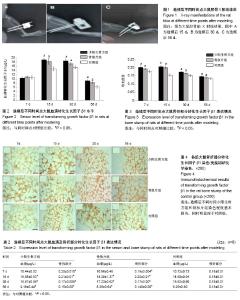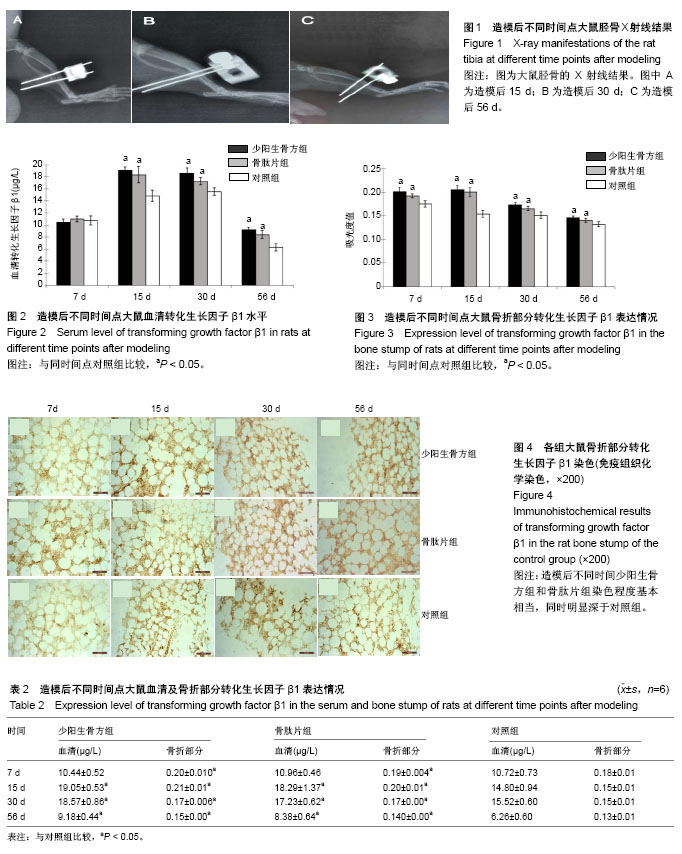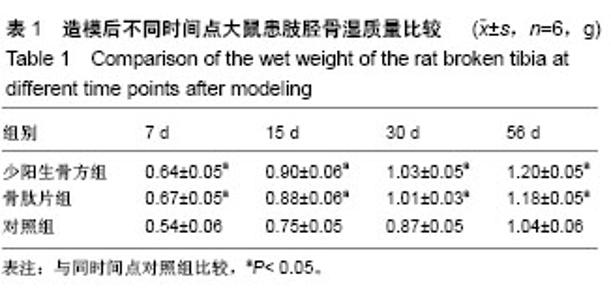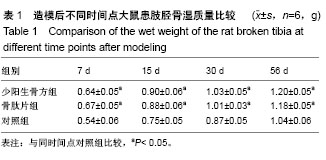| [1] Calori GM, Mazza EL, Mazzola S, et al. Non-unions. Clin Cases Miner Bone Metab. 2017;14(2):186-188.[2] Buza JA. Bone healing in 2016.Clin Cases Miner Bone Metab. 2016;13(2):101-105.[3] Eldesoqi K, Henrich D, El-Kady AM, et al. Safety evaluation of a bioglass-polylactic acid composite scaffold seeded with progenitor cells in a rat skull critical-size bone defect. PLoS One. 2014;9(2): e87642.[4] 毕志伟,黄东,欧阳海洋.同种异体骨移植治疗骨缺损的应用研究进展[J].中国临床解剖学杂志,2014,32(05):623-625.[5] Ferreira E Costa R, Oliveira MR, Gabrielli MAC, et al. Postoperative Complications Associated With Different Fixation Methods of Isolated Mandibular Angle Fractures. J Craniofac Surg. 2018. doi: 10.1097/SCS.0000000000004484.[6] Lovy AJ, Kim JS, Di Capua J, et al. Intramedullary Nail Fixation of Atypical Femur Fractures With Bone Marrow Aspirate Concentrate Leads to Faster Union: A Case - Control Study. J Orthop Trauma.2017;31(7):358-362.[7] Dawson JI, Smith JO, Aarvold A, et al. Enhancing the osteogenic efficacy of human bone marrow aspirate: concentrating osteoprogenitors using wave-assisted filtration.Cytotherapy. 2013;15(2):242-252.[8] Wang CJ, Yang KD, Ko JY, et al. The effects of shockwave on bone healing and systemic concentrations of nitric oxide (NO), TGF-beta1, VEGF and BMP-2 in long bone non-unions. Nitric Oxide. 2009; 20(4): 298-303.[9] Goshima K, Sawaguchi T, Shigemoto K, et al. Effect of Low-Intensity Pulsed Ultrasound on Bone Healing at Osteotomy Sites After Open Wedge High Tibial Osteotomy. J Orthop Trauma. 2017;31(7):S3-S4.[10] Ongaro A, Pellati A, Bagheri L, et al. Pulsed electromagnetic fields stimulate osteogenic differentiation in human bone marrow and adipose tissue derived mesenchymal stem cells. Bioelectromagnetics.2014;35(6):426-436.[11] Grassmann JP, Schneppendahl J, Hakimi AR, et al. Hyperbaric oxygen therapy improves angiogenesis and bone formation in critical sized diaphyseal defects. J Orthop Res. 2015;33(4): 513-520.[12] Puolakkainen T, Rummukainen P, Lehto J, et al. Soluble activin type IIB receptor improves fracture healing in a closed tibial fracture mouse model. PLoS One.2017;12(7):e0180593.[13] Bambini F, Santarelli A, Putignano A, et al. Use of supercharged cover screw as static magnetic field generator for bone healing, 2nd part: in vivo enhancement of bone regeneration in rabbits. J Biol Regul Homeost Agents.2017;31(2):481-485.[14] Guzel N, Sayit E, Aynaci O, et al. Ginkgo Biloba improves bone formation during fracture healing: an experimental study in rats. Acta Ortop Bras.2017;25(3):95-98.[15] 扶世杰,杨本伍,舒从科,等.少阳生骨方对大鼠在体软骨损伤关节液IL-1β及软骨修复组织Ⅱ型胶原影响的实验研究[J].分子诊断与治疗杂志,2014,6(03):191-197.[16] 沈骅睿,李婷,扶世杰,等.少阳生骨方含药血清对促进大鼠体外软骨细胞培养细胞增殖的相关性研究[J].成都中医药大学学报, 2013, 36(02):16-18.[17] 李翠娟,王琳,巩振东.固本活血壮骨颗粒对糖尿病大鼠BMD及骨组织IL-1、转化生长因子β1表达的影响[J].辽宁中医杂志, 2016,43(05): 1067-1069+7.[18] Shi M, Zhu J, Wang R, et al. Latent TGF-β structure and activation. Nature.2011;474(7351):343-349. [19] 杨森,王海龙,盛伟斌,等.骨折合并脊髓损伤患者血清中转化生长因子β1变化:有利于促进骨折愈合[J].中国组织工程研究, 2015,19(02): 165-169.[20] Hara Y, Ghazizadeh M, Shimizu H, et al. Delayed Expression of Circulating TGF-β 1 and BMP-2 Levels in Human Nonunion Long Bone Fracture Healing. J Nippon Med Sch. 2017;84(1):12-18.[21] Cho TJ, Gerstenfeld LC. Differential temporal expression of members of the transforming growth factor beta superfamily during murine fracture healing. J Bone Miner Res. 2002;17(3): 513-520.[22] Fischer C, Doll J, Tanner M, et al. Quantification of TGF-β1, PDGF and IGF-1 cytokine expression after fracture treatment vs non-union therapy via masquelet.Injury. 2016;47(2):342-349.[23] Frenkel SR, Saadeh PB, Mehrara BJ, et al. Transforming growth factor beta superfamily members: role in cartilagemodeling. Plast Reconstr Surg.2000;105(3):980-990.[24] Cheung KM, Kaluarachi K, Andrew G, et al. An externally fsxed femoral fracture model for mice. J Orthop Res. 2003;21(4): 685-90.[25] 徐叔云.药理学实验方法.北京:人民卫生出版社,2002,203-204.[26] Ma WH, Liu YJ, Wang W. Neuropeptide Y, substance P, and human bone morphogenetic protein 2 stimulate human osteoblastosteogenic activity by enhancing gap junction intercellular communication. Braz J Med Biol Res. 2015;48(4): 299-307.[27] Harford JS, Dekker TJ. Bone Marrow Aspirate Concentrate for Bone Healing in Foot and Ankle Surgery. Foot Ankle Clin. 2016; 21(4):839-845.[28] Bambini F, Santarelli A, Putignano A, et al. Use of supercharged cover screw as static magnetic field generator for bone healing, 2nd part: in vivo enhancement of bone regeneration in rabbits. J Biol Regul Homeost Agents.2017;31(2):481-485. [29] 孟新民,孙晓雷,马剑雄,等.内皮祖细胞与骨折愈合:培养与移植中的问题[J].中国组织工程研究,2014,18(45):7353-7357[30] 林梁,唐亚辉,吾路汗,等.骨折愈合过程中原始骨折血肿的潜在作用[J].中国组织工程研究,2015,19(46):7386-7390.[31] Schneppendahl J, Jungbluth P, Sager M, et al. Synergistic effects of HBO and PRP improve bone regeneration with autologous bone grafting.Injury.2016;47(12):2718-2725.[32] Zhang Y, Xu J, Ruan YC, et al. Implant-derived magnesium induces local neuronal production of CGRP to improve bone-fracture healing in rats. Nat Med.2016;22(10):1160-1169.[33] Zhang R, Lee P, Lui VC, et al. Silver nanoparticles promote osteogenesis of mesenchymal stem cells and improve bone fracture healing in osteogenesis mechanism mouse model. Nanomedicine.2015;11(8):1949-1959.[34] Shi Y, He G, Lee WC,et al. Gli1 identifies osteogenic progenitors for bone formation and fracture repair. Nat Commun. 2017;8(1): 2043.[35] 张坤,牛良晨,袁福杰,等.中药促进骨折愈合在细胞分子水平的研究进展[J].中国骨伤,2017,30(08):777-782.[36] 王鸿度,扶世杰,陈庄,等.电针足少阳经穴对去卵巢大鼠骨质疏松的作用[J].中医杂志,2011, 52(04):322-325.[37] 范薇,杨剑,夏丽娜,等.从“少阳主骨”看阳陵泉穴对艾灸治疗佐剂性关节炎大鼠的抗炎增效作用[J].辽宁中医杂志,2017,44(4): 852-854.[38] 范薇,杨剑,夏丽娜.从“少阳主骨”看少阳对骨之作用机制[J].时珍国医国药,2016,252(08):1955-1956.[39] Wang HD, Zhang FZ, You H, et al.Study on the theory of "Shaoyang Meridians being in charge of the bone". Zhongguo Zhen Jiu.2008;28(6):469-471.[40] 姜溪,陈芙蓉,任雷鸣,等.注射用复方骨肽的药效学及其作用机制研究[J].现代药物与临床,2017,32(06):961-966.[41] 马洁,宋燕青.骨肽注射液的临床应用及其药理作用[J].中国生化药物杂志,2016,36(02):16-18. |



